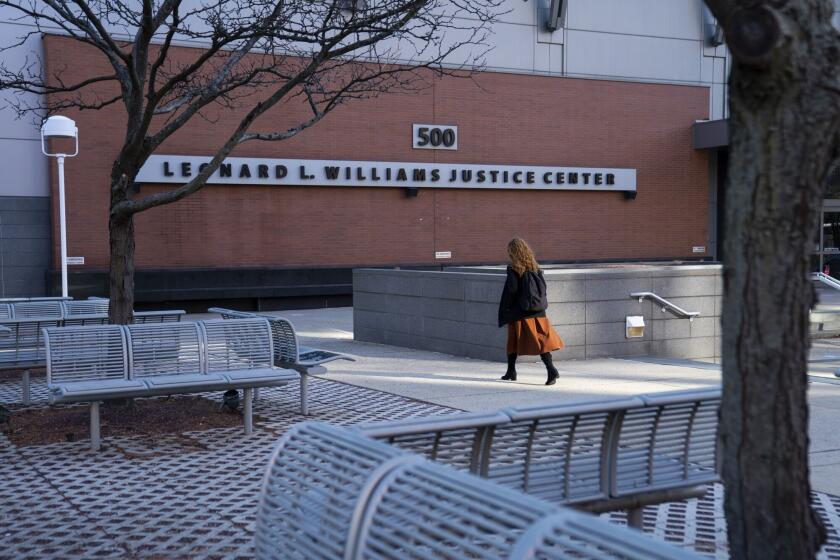What Sellers Need to Know About Megan’s Law
- Share via
If you’ve ever sold a home, you know you have to ‘fess up to the buyer about your leaky roof, the airport noise and the nearby flood plain. But the disclosure thicket is getting even thicker.
Starting July 1, all California home sellers will be required to notify buyers about a database that lists convicted sex offenders living in the area.
Known informally as the Megan’s Law database, the CD-ROM of about 70,000 California registered sex offenders is accessible by the public at many police and sheriff’s stations, and has been for nearly two years.
But although the public can view the names of registered offenders within any ZIP Code in the state, they cannot learn addresses of registered offenders.
And with some ZIP Codes comprising as many as 29,500 households, checking out the Megan’s Law database may be of scant use to a home buyer who’s moving into a new neighborhood, critics say.
Even some Realtors acknowledge that the new disclosure is designed primarily to shield them from lawsuits.
“It’s there to protect Realtors so that if there is a problem in the neighborhood, people don’t come back to us and say, ‘You should have told me, you should have known,’ ” said Realtor Sheila Pope of Sunbelt Properties in Long Beach.
For years, standard real estate purchase agreements have included a paragraph advising buyers that they should investigate various neighborhood characteristics, including crime statistics and the “proximity of registered felons or offenders.”
“In California, there’s the rule that if you know about anything materially affecting the property, you have to disclose it,” said June Barlow, general counsel for the California Assn. of Realtors.
The question with the sex offender issue, she said, has been where to draw the line.
Do Realtors need to check the database themselves? Could they be liable if a buyer later discovered his or her neighbor was a sex offender?
Under an amendment to California’s Megan’s Law, introduced by state Sen. Richard Polanco (D-Los Angeles) and signed into law by former Gov. Pete Wilson in September, Realtors duties’ become a little clearer, Barlow said.
The amended law requires that a section be included on all purchase and lease agreements that tells buyers about the existence of the Megan’s Law database and a 900 phone number known as the Sex Offender Identification Line.
The disclosure is legally required as of Thursday, though many realty agents have been using new forms from the California Assn. of Realtors that include the information since April, group officials said.
Megan’s Law refers to a 1996 federal law named after 7-year-old Megan Kanka, who was raped and killed in 1994 by a twice-convicted sex offender who had moved into her New Jersey neighborhood unbeknownst to her parents.
The federal statute requires states to register the names and whereabouts of convicted criminals whose victims were minors or who committed sexually violent offenses.
Law enforcement agencies are also required to release relevant information about sex offenders when necessary to protect the public.
*
As part of California’s version of Megan’s Law, also adopted in 1996, law enforcement authorities in jurisdictions of more than 200,000 residents are required to make statewide sex offender data available to the public on a CD-ROM compiled by the state Department of Justice.
The database--which includes offenders whose crimes date as far as the mid-1940s--is updated monthly. Offenders must re-register annually and whenever they move.
Det. Paul Bishop of the Los Angeles Police Department’s West Los Angeles Division contends that checking the Megan’s Law database should be a common practice any time one moves, just like finding out about an area’s crime rates or schools.
Most people who come to look at the database expect that they are going to be able to see the exact locations of offenders in their area.
But although law enforcement officers have access to the addresses of the individuals on the CD-ROM, the public does not.
“Sex registrants have rights,” Bishop said. “Not being the victim of vigilante action is one of them.”
The general public can find out the names of all registered offenders within a ZIP Code, the nature of their crimes, plus physical descriptions, birth dates, aliases and distinguishing scars or tattoos. For many, photos are also included.
“Every area has a sex registrant in it,” Bishop said, so home buyers hoping to find a ZIP Code without any offenders are probably out of luck.
Although the Megan’s Law database can be a useful tool for parents, police say, it’s more important they know who their children spend time with.
Most sex offenders exploit children they’ve befriended, rather than assaulting children at random, Bishop said.
Elizabeth Schroeder, associate director of the American Civil Liberties Union of Southern California and a vocal critic of the California Megan’s Law, believes the database is of little use to home buyers.
ZIP Codes of tens of thousands of households can contain several people with the same or similar names, Schroeder said, so simply knowing the names of all the offenders in an area may be meaningless when it comes to protecting yourself or family.
The database contains inaccuracies, she said, can encourage acts of vigilantism, and may either overstate or understate the risks in a given neighborhood.
For example, the data may include people whose only crimes were committed up to 55 years ago and who are completely rehabilitated but are still legally obligated to register, she said. On the other hand, the database cannot tell parents about local perpetrators who have never been caught or convicted.
“We fail as a society to realize that 90% of sex crimes against children take place in the home by . . . fathers, brothers, uncles, boyfriends. And those names are never on the CD-ROM,” she said.
“Going to the database to find out if there’s a sex offender in the neighborhood doesn’t relieve [people] of their responsibility as parents to watch out for the safety of their children.”
Most densely populated parts of the state have between 30 and 70 sex offenders per ZIP Code, said Michael Van Winkle, a spokesman for the state attorney general. Some can have up to 300, he said.
*
A look at 70 ZIP Codes ranging from Ventura County to southern Orange County showed that most had between 15 and 75 resident offenders. One ZIP Code, however, had 276 (90011, south of downtown Los Angeles), one had 220 (90650, in Norwalk), while others had only three (92604, Irvine) and four (90403, Santa Monica).
And ZIP Codes vary in terms of how many households they include. According to real estate information firm Axciom/Dataquick, ZIP Codes in Southern California range from about 29,500 households (92677, in Laguna Niguel) to nine households (93563, in Valyermo, at the northeastern edge of the Angeles National Forest). West L.A.’s 90049 includes about 17,800, while 90230 in Culver City has 13,000 households.
Information about California’s registered sex offenders is not widely available online. One reason is that it’s against the law to mechanically copy information from the CD-ROM. Citizens may only take down the information by hand.
Another reason is that it is illegal for sex offenders to access the database. Authorities also fear that if the data were online, hackers could add the names of innocent people.
To prevent sex offenders from accessing the Megan’s Law database, those wishing to view it must provide police with their names, addresses and driver’s license number. Police check that the visitor is not an offender before allowing him or her onto the database. Only those over age 18 may access the database or use the 900-number service.
Realtor Bill Podley, president of Pasadena-based Podley Caughey & Doan, said his 150 agents have been using forms with the sex offender paragraph since May.
Few of the clients they work with are aware of Megan’s Law, he said, adding that perhaps the new disclosure paragraph will educate people about it, as well as provide legal protection for real estate agents and sellers.
“We’re grateful to have a mechanism for people to find out for themselves, rather than expect their Realtor to go and ascertain for every property being sold if a registered offender is in close proximity to [it],” Podley said.
For more information about California’s Megan’s Law, consult the state attorney general’s home page at https://caag.state.ca.us/
Purchase Agreement Wording
Here is the text of Section 7E of the Residential Purchase Agreement published by the California Assn. of Realtors. This exact paragraph is legally required to be part of all purchase and lease agreements for one- to four-unit residential dwellings beginning July 1:
NOTICE: The California Department of Justice, sheriff’s departments, police departments serving jurisdictions of 200,000 or more and many other local law enforcement authorities maintain for public access a database of the locations of persons required to register pursuant to paragraph (1) of subdivision (a) of Section 290.4 of the Penal code. The database is updated on a quarterly basis and a source of information [sic] about the presence of these individuals in any neighborhood. The Department of Justice also maintains a Sex Offender Identification Line, through which inquiries about individuals may be made. This is a 900 telephone service. Callers must have specific information about individuals they are checking. Information regarding neighborhoods is not available through the “900” telephone service.
Note: The 900 number, which is not printed on the purchase form, is (900) 463-0400. The cost is $10 to inquire about a maximum of two individuals.
More to Read
Inside the business of entertainment
The Wide Shot brings you news, analysis and insights on everything from streaming wars to production — and what it all means for the future.
You may occasionally receive promotional content from the Los Angeles Times.










